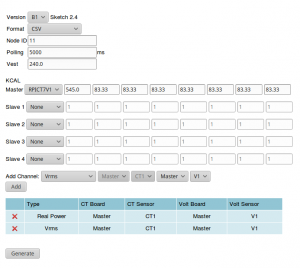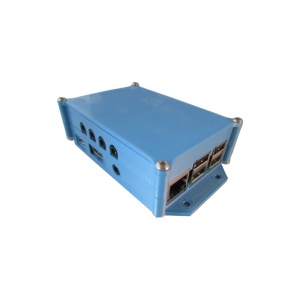RPICT4V3 Version 5
RPICT4V3 Version 5

This page is for board specific information. More information can be found on the generic page for RPICT series.
Overview
- 4 AC current sensors.
- 3 AC Voltage sensors.
- Compute real power.
- Fit on Raspberrypi 4 holes mounting pattern.
- AtMega328 Mcu (Arduino UNO)
- MCP3208 12 bits ADC
- Stackable (up to 5 boards together)
A typical application for the RPICT4V3 is 3 phase systems power reading. The 3 voltages are coupled with 3 CT to perform power computation on each line.
Compatibility
| Version | Compatible? |
|---|---|
| Raspberrypi 1 A | No |
| Raspberrypi 1 B+ | Yes |
| Raspberrypi 2 B | Yes |
| Raspberrypi 3 B | Yes |
| Raspberrypi 3 B+ | Yes |
| Raspberrypi 4 B | Yes |
- Asus Tinkerboard has been reported to work with RPICT units. Note we won't be able to provide support for the Tinkerboard.
Recommended sensors
- AC Current sensor:
- SCT-013-000
- SCT-019
- SCT-006
- AC Voltage sensor:
- ZMPT101B Module
- UK: 77DB-06-09
- EU: 77DE-06-09
- US: 77DA-10-09
VOLTAGE OUTPUT CT SUCH AS SCT-013-030 and other SCT-013-0XX ARE NOT COMPATIBLE WITH THIS BOARD. Only use the SCT-013-000 which is a current output CT.
Stacking Configuration
General stacking information is described in the RPICT stacking page. RPICT_Stacking Version 5
Software Configuration
Using a serial line terminal program one can configure the following:
- Polling interval - Output format (csv or emoncms) - Calibration values (Voltage and Current) - Voltage/current combinations for real power computation. - Output channels
The documentation for serial configuration can be found on this page.
Over Serial Configuration - Sketch 3.0
 The board can be configured with the online configurator.
The board can be configured with the online configurator.
Files
Default Sketch
(note boards are sold already flashed with latest firmware).
noOSC Sketch
The Default sketch allows up to 28 computation nodes to be run. If more are needed for higher stacks then we recommend to use the noOSC sketch. This is the same as the default sketch but Over Serial Configuration (OSC) as been removed to allow up to 40 nodes to be computed. Configuration has to be edited in the sketch.
noOSC Sketch v1.0
noOSC Sketch v1.1
Simple Python Example
The example python script below will work well with the default configuration.
import serial
ser = serial.Serial('/dev/ttyAMA0', 38400)
try:
while 1:
# Read one line from the serial buffer
line = ser.readline()
# Remove the trailing carriage return line feed
line = line[:-2]
# Create an array of the data
Z = line.split(' ')
# Print it nicely
if len(Z)>16:
print ("----------")
print (" \tCT1\tCT2\tCT3\tCT4")
print ("Vrms :\t%s\t%s\t%s\t%s" % (Z[1], Z[2], Z[3], Z[4]))
print ("RealPower:\t%s\t%s\t%s\t%s" % (Z[5], Z[6], Z[7], Z[8]))
print ("Irms :\t%s\t%s\t%s\t%s" % (Z[9], Z[10], Z[11], Z[12]))
print ("P Factor :\t%s\t%s\t%s\t%s" % (Z[13], Z[14], Z[15], Z[16]))
except KeyboardInterrupt:
ser.close()To run this first of all make sure you have python-serial package installed
$ sudo apt-get install python-serial
Then run the command below to download the script.
wget lechacal.com/RPICT/example/RPICT4V3_DEMO_02.py.zip unzip RPICT4V3_DEMO_02.py.zip
and run it using
python RPICT4V3_DEMO_02.py
Data Output
Using the manufacture firmware the data output is:
NodeID Vrms1 Vrms2 Vrms3 Vrms4 Realpower1 Realpower2 Realpower3 Realpower4 Irms1 Irms2 Irms3 Irms4 PF1 PF2 PF3 PF4
Real Powers are computed using the following rules:
RealPower1 -> CT1 & V1
RealPower2 -> CT2 & V2
RealPower3 -> CT3 & V3
RealPower4 -> CT4 & V3
These rules can be modified in the configuration if needed.
Other output type can be streamed out. This should be configured in the unit.
All outputs type available are
- Vrms (V)
- Irms (mA)
- Real Power (W)
- Apparent Power (W)
- Power Factor
- Estimated Power
- Frequency
- Reactive Power
Restore Default Config
$ wget lechacal.com/RPICT/config/B4/rpict4v3_3phase.conf $ lcl-rpict-config.py -w rpict4v3_3phase.conf
These command above will restore the default configuration for a 100A rated board. For all other rating see the corresponding table here.
Then for parameter kcal replace all the 83.33 with the corresponding calibration coefficient found in the table.
Emoncms Config (Emonhub)
Make sure you read this first.
For default configuration.
[[11]]
nodename = RPICT4V3
hardware = RPICT4V3
[[[rx]]]
names = Vrms1,Vrms2,Vrms3,Vrms4,Realpower1,Realpower2,Realpower3,Realpower4,Irms1,Irms2,Irms3,Irms4,PF1,PF2,PF3,PF4
datacode = 0
scales = 1,1,1,1,1,1,1,1,1,1,1,1,1,1,1,1
units = V,V,V,V,W,W,W,W,mA,mA,mA,mA
Enclosure
Enclosures kit are available as a 3D printed product. Link to the shop.
Both Raspberrypi 3 and 4 format are available.
Related Pages
Howto_setup_Raspbian_for_serial_read


